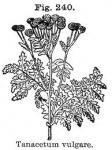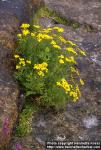
 Related entries: Parthenium.—Feverfew - Pyrethrum (U. S. P.)—Pyrethrum - Oleum Tanaceti.—Oil of Tansy
Related entries: Parthenium.—Feverfew - Pyrethrum (U. S. P.)—Pyrethrum - Oleum Tanaceti.—Oil of Tansy
"The leaves and tops of Tanacetum vulgare, Linné"—(U. S. P.) (Chrysanthemum Tanacetum, Karsch).
Nat. Ord.—Compositae.
COMMON NAME: Tansy.
Botanical Source.—Tansy has a perennial, moderately creeping root, and an erect, herbaceous, somewhat 6-sided, leafy, solid, striated, smooth stem, 1 to 3 feet in height, branched above into a handsome corymb of flowers. The leaves are smoothish, dark-green, and doubly and deeply pinnatifid; the segments oblong-lanceolate, pinnatifid, and incisely serrate; the margined petiole cut-toothed. The flowers are golden-yellow, in dense, terminal, many-headed, fastigiate corymbs; disk florets 5-cleft and perfect; ray florets few, trifid, and pistillate. Scales of the involucre scarious at the apex, small, obtuse, and imbricated. Pappus short, equal, membranous, and 5-lobed; the achenia with a quadrangular, entire crown. There is a variety called Double tansy (Tanacetum crispum), with crisped and dense leaves (L.—W.—G.).
History and Description.—Tansy is indigenous to Europe, but has been introduced into this country. It is cultivated by many, and also grows spontaneously in old grounds, along roads, etc., flowering in the latter part of summer. The whole plant is medicinal. It has an unpleasant, aromatic odor, and a strong, rather pungent and bitter taste, which properties it partly owes to a yellow or greenish volatile oil. The medicinal virtues of the plant are extracted by alcohol, ether, chloroform, and by water in infusion. Drying impairs much of its activity. The U. S. P. describes tansy as follows: "Leaves about 15 Cm. (6 inches) long; bipinnatifid, the segments oblong, obtuse, serrate or incised, smooth, dark-green, and glandular; flower-heads corymbose, with an imbricated involucre, a convex, naked receptacle, and numerous yellow, tubular florets; odor strongly aromatic; taste pungent and bitter"—(U. S. P.). Though well known to the ancients, it is not known when tansy came into medical use. According to an Egyptian legend, its properties were discovered by the deity Isis.
Chemical Composition.—The principal constituent of the herb is the volatile oil, or oil of tansy (see Oleum Tanaceti). In addition, a bitter, amorphous principle, tanacetin (C11H16O4), is present (Leroy, 1845; Leppig, 1882), occurring chiefly in the flowers. It is soluble in water and alcohol, insoluble in ether, although Roder states (Archiv der Pharm., Vol. XCVII, 1846, p. 109) that it is very little soluble in water. The herb also contains tannic acid, resin, malic acid (probably the tanacetic acid of Peschier), tartaric, citric, and oxalic acids, etc.
Action, Medical Uses, and Dosage.—Oil of tansy is a poisonous agent, killing by coma and asphyxiation. The effects are different according to the amount taken. The symptoms may be chiefly gastro-intestinal, or they may be spent mainly upon the nervous system. Thus vomiting and purging, with colicky pains were present in one case, the patient dying in collapse, but the mind remained clear to the last. In other cases there have been increased frequency of the pulse, pupillary dilatation, insensibility, convulsions, with frothing at the mouth, and, occasionally, death is preceded by paralysis of motion, swallowing, and respiration. Doses above 15 or 20 drops are highly dangerous.
Tansy is tonic, emmenagogue, and diaphoretic. In small doses, the cold infusion will be found useful in convalescence from exhausting diseases, in dyspepsia, with troublesome flatulence, hysteria, jaundice, and worms. A warm infusion is diaphoretic and emmenagogue, and has been found beneficial in intermittent fever, suppressed menstruation, tardy labor-pains, and as a preventive for the paroxysms of gout. The seeds are reputed the most efficient for worms. The oil is likewise used as an anthelmintic, and as an abortive, but for the last purpose it is highly dangerous and generally ineffectual. Tansy is much employed in the form of fomentation to swellings and tumors, local inflammations, etc., and applied to the bowels in amenorrhoea, and painful dysmenorrhoea. The vinous infusion is said to be beneficial in strangury, and other urinary obstructions, and in debility of the kidneys. By means of a spray or inhalation, a solution of a strong tincture (1 to 4 or 10) is valuable in diphtheria, acute inflammations of the throat, and in epidemic catarrh (Scudder). The dose of the powder is from 30 to 60 grains, every 3 or 4 hours; of the infusion, from 1 to 4 fluid ounces; of the tincture of fresh tansy (℥viii to alcohol, 76 per cent, Oj), 1 to 30 drops; of the oil, from 2 to 10 drops. A very pleasant compound tincture may be made by adding tansy, 2 ounces; swamp milkweed, 1 ounce; unicorn root and prickly ash berries, of each, ounce; to 2 pints of diluted alcohol. Let them macerate for 14 days, and filter. This is useful as a vermifuge and tonic, and may be given to a child 2 or 3 years old, in doses of a teaspoonful, 3 or 4 times a day, in sweetened water.
Related Species.—Tanacetum Balsamita, Linné (Balsamita suaveolens, Persoon; Pyrethrum Tanacetum, De Candolle). This south European perennial is known as the Costmary. Its taste is bitter, and its odor strongly aromatic. It is official in the French Codex, and is employed for the same purposes as tansy.
Tanacetum umbelliferum, Sweet pellitory.—India. Contains an organic pigment, acid, wax, fat, glucose, inulin, and a small quantity of pyrethrin (compare Pyrethrum) (D. Hooper, Pharm. Jour. Trans., Vol. XXI, p. 143).

